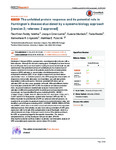The unfolded protein response and its potential role in Huntington's disease elucidated by a systems biology approach
| dc.contributor.author | Kalathur, RKR | |
| dc.contributor.author | Giner-Lamia, J | |
| dc.contributor.author | Machado, S | |
| dc.contributor.author | Barata, T | |
| dc.contributor.author | Ayasolla, KRS | |
| dc.contributor.author | Futschik, Matthias | |
| dc.date.accessioned | 2017-02-07T20:10:23Z | |
| dc.date.available | 2017-02-07T20:10:23Z | |
| dc.date.issued | 2015 | |
| dc.identifier.issn | 2046-1402 | |
| dc.identifier.issn | 2046-1402 | |
| dc.identifier.uri | http://hdl.handle.net/10026.1/8419 | |
| dc.description.abstract |
<ns4:p>Huntington ́s disease (HD) is a progressive, neurodegenerative disease with a fatal outcome. Although the disease-causing gene (huntingtin) has been known for over 20 years, the exact mechanisms leading to neuronal cell death are still controversial. One potential mechanism contributing to the massive loss of neurons observed in the brain of HD patients could be the unfolded protein response (UPR) activated by accumulation of misfolded proteins in the endoplasmic reticulum (ER). As an adaptive response to counter-balance accumulation of un- or misfolded proteins, the UPR upregulates transcription of chaperones, temporarily attenuates new translation, and activates protein degradation via the proteasome. However, persistent ER stress and an activated UPR can also cause apoptotic cell death. Although different studies have indicated a role for the UPR in HD, the evidence remains inconclusive. Here, we present extensive bioinformatic analyses that revealed UPR activation in different experimental HD models based on transcriptomic data. Accordingly, we have identified 53 genes, including RAB5A, HMGB1, CTNNB1, DNM1, TUBB, TSG101, EEF2, DYNC1H1, SLC12A5, ATG5, AKT1, CASP7 and SYVN1 that provide a potential link between UPR and HD. To further elucidate the potential role of UPR as a disease-relevant process, we examined its connection to apoptosis based on molecular interaction data, and identified a set of 40 genes including ADD1, HSP90B1, IKBKB, IKBKG, RPS3A and LMNB1, which seem to be at the crossroads between these two important cellular processes. Remarkably, we also found strong correlation of UPR gene expression with the length of the polyglutamine tract of Huntingtin, which is a critical determinant of age of disease onset in human HD patients pointing to the UPR as a promising target for therapeutic intervention. The study is complemented by a newly developed web-portal called UPR-HD (http://uprhd.sysbiolab.eu) that enables visualization and interactive analysis of UPR-associated gene expression across various HD models.</ns4:p> | |
| dc.format.extent | 103-103 | |
| dc.format.medium | Electronic-eCollection | |
| dc.language | en | |
| dc.language.iso | eng | |
| dc.publisher | F1000 Research Ltd | |
| dc.subject | Apoptosis | |
| dc.subject | HTT interactome | |
| dc.subject | Huntington's disease | |
| dc.subject | UPR interactome | |
| dc.subject | Unfolded protein response (UPR) | |
| dc.title | The unfolded protein response and its potential role in Huntington's disease elucidated by a systems biology approach | |
| dc.type | journal-article | |
| dc.type | Journal Article | |
| plymouth.author-url | https://www.ncbi.nlm.nih.gov/pubmed/26949515 | |
| plymouth.volume | 4 | |
| plymouth.publication-status | Published online | |
| plymouth.journal | F1000Research | |
| dc.identifier.doi | 10.12688/f1000research.6358.2 | |
| plymouth.organisational-group | /Plymouth | |
| plymouth.organisational-group | /Plymouth/Faculty of Health | |
| plymouth.organisational-group | /Plymouth/Users by role | |
| dc.publisher.place | England | |
| dcterms.dateAccepted | 2016-02-22 | |
| dc.identifier.eissn | 2046-1402 | |
| dc.rights.embargoperiod | Not known | |
| rioxxterms.versionofrecord | 10.12688/f1000research.6358.2 | |
| rioxxterms.licenseref.uri | http://www.rioxx.net/licenses/all-rights-reserved | |
| rioxxterms.licenseref.startdate | 2015 | |
| rioxxterms.type | Journal Article/Review |


